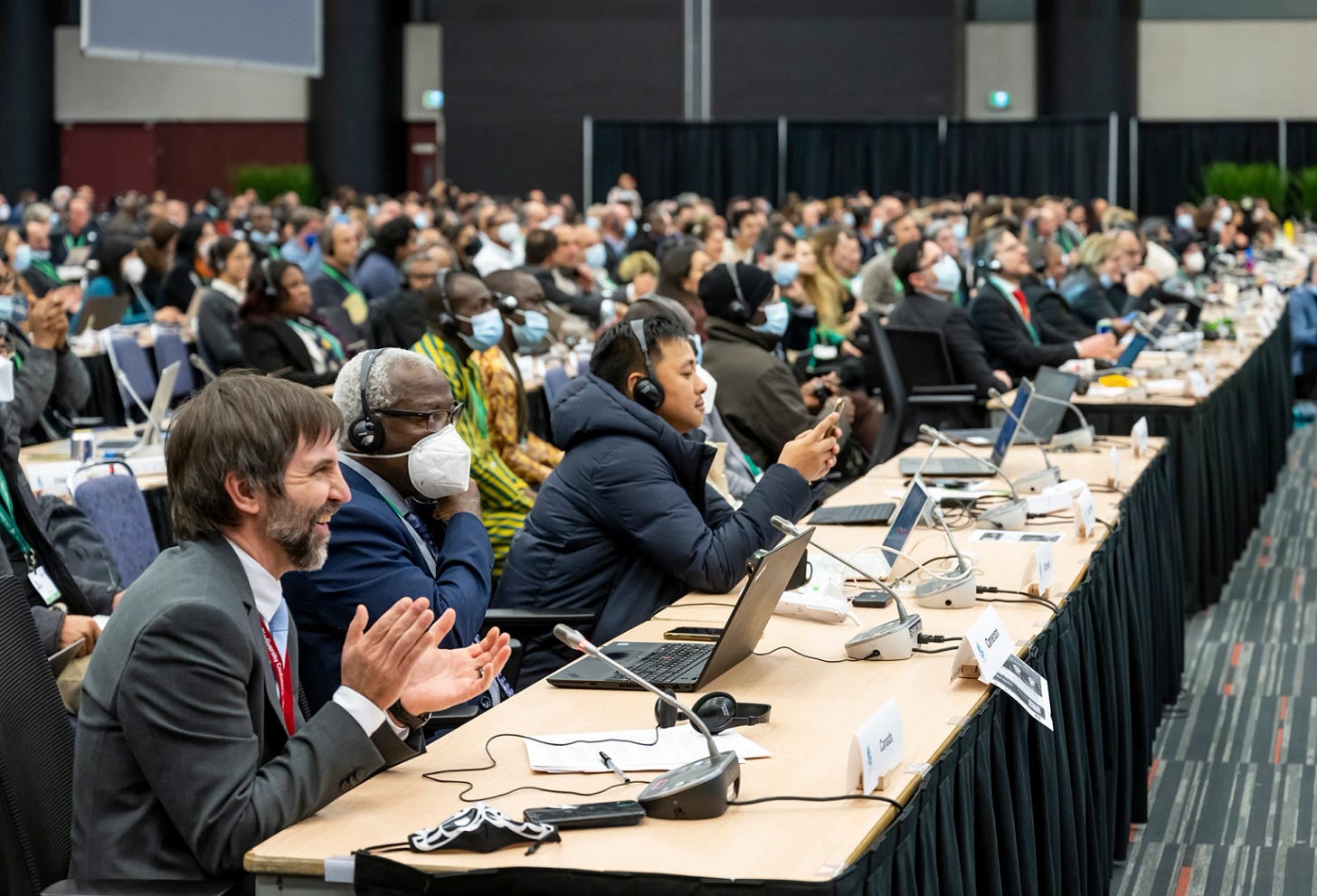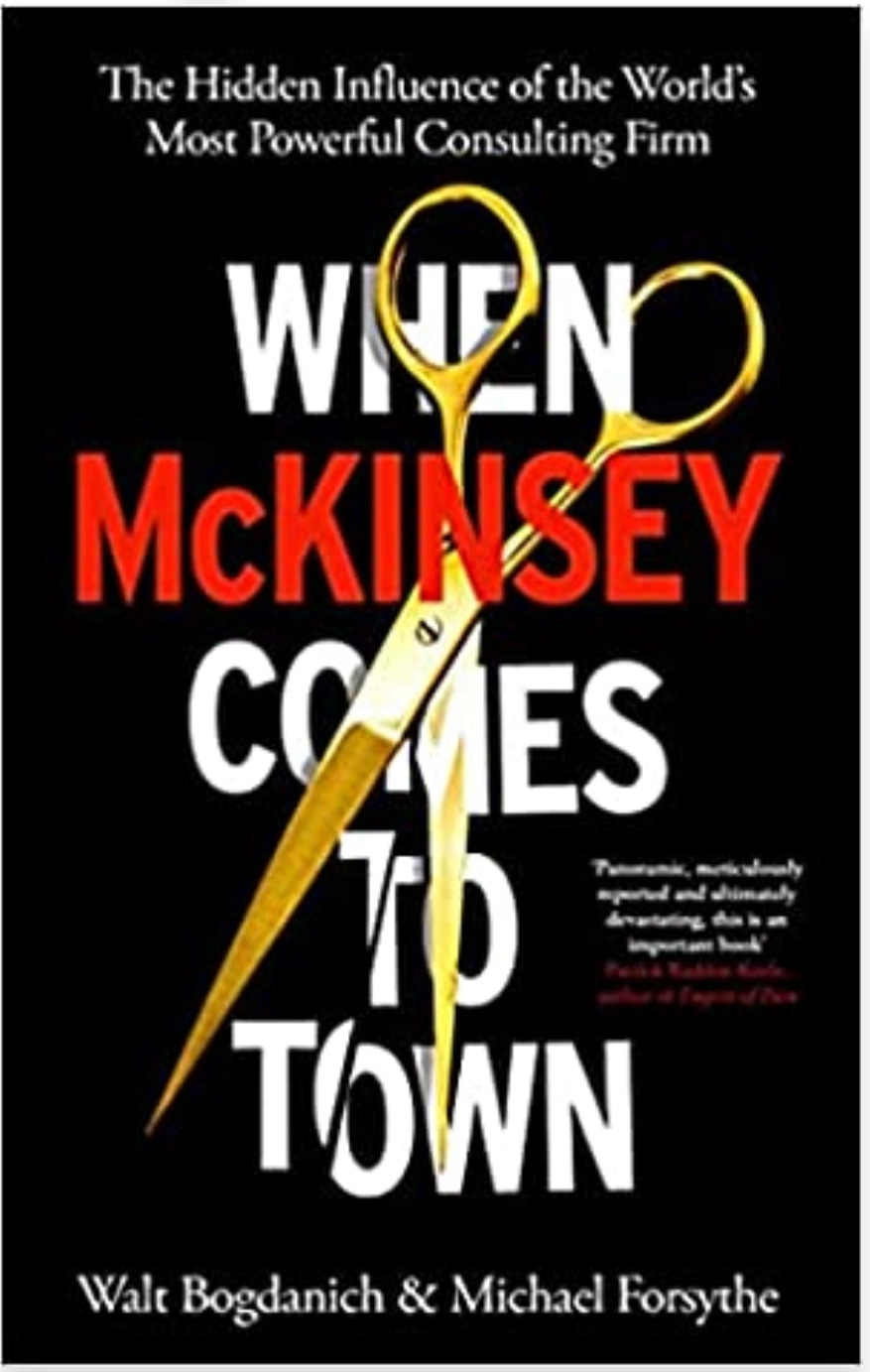Happy New Year! And welcome to Just Two Things, which I try to publish three days a week. Some links may also appear on my blog from time to time. Links to the main articles are in cross-heads as well as the story. A reminder that if you don’t see Just Two Things in your inbox, it might have been routed to your spam filter. Comments are open.
1: How to pay for 30 x 30
It got a bit lost in the news cycle because it closed so close to Christmas, but the COP15 conference—formally, the meeting of the Convention on Biological Diversity—in Montreal did finally agree some important things. It probably didn’t do quite as much as it needed to (more on that below) but given that the mood music going into the meeting, and over the first week, was both depressed and depressing, something valuable came out of the event.
The final agreement was reached at 3.30am in the morning, after two very late nights. I’m always struck by the way in which a combination of a deadline and sleep deprivation seems to help delegates to overcome their differences and agree on something. At that stage they’ll probably sign anything to be allowed to go home.
(Delegates applaud after the Global Biodiversity Framework is adopted in the small hours of 19 December 2022 in Montreal. Photo: UN Biodiversity)
Anyway, it’s worth summarising the good stuff here first. The South African paper Daily Maverick had a detailed summary.
The headline: that countries committed
the world to halt and reverse biodiversity loss by 2030, a global goal hailed as the equivalent of the 1.5°C climate target.
It’s also worth noting that
nature loss is one-third of the climate problem but nature can contribute to one-third of the solution.
The headline agreement is on the target known as 30 x 30:
to effectively conserve at least 30% of the world’s lands, freshwater and oceans (by 2030), while respecting the rights and contribution of indigenous peoples and local communities.“The ‘30×30’ target marks the largest land and ocean conservation commitment in history,” said Brian O’Donnell, director of the Campaign for Nature.
Currently 17% of terrestrial areas, and 10% of marine areas are under protection.
The final text said that $700 billion would be available to help to achieve this, of which $500 billion would come from reforming or removing harmful subsidies, and $200 billion from mobilising protection for diversity, from multiple sources.
COP15 agreed to set up a Global Biodiversity Fund, which is a dedicated fund for biodiversity. Some delegates wanted this to be independent of the United Nations, but it will be run under the umbrella of the existing UN Global Environmental Fund (GEF). There’s more on why this is controversial later in the piece. All the same, the resources agreement
includes a number of important elements on access, adequacy, predictability, equitable governance and financing from all sources — meaning it might be easier for private financiers to donate to this fund.
$700 billion sounds like a lot, but analysts estimate that it will take $1 trillion to implement 30 x 30. And the minute there’s mention of ‘reforming’ harmful subsidies the world’s lobbyists are in there like wasps to a jam pot.
Agreement was also agreed on how to progress an issue known as ‘Digital Sequence Information’, which effectively would allow researchers and others to access genetic information about an organism. This is already used in a wide range of commercial and non-commercial activities, but access to the DSI, and how benefits are distributed, is not straightforward:
How this genetic information is accessed by researchers, and how countries of origin can benefit from it, is a very contentious issue. Once the genomic sequence data and other related digital data are in an international database, you no longer need to go back to a country to get an organism sample.
Again, the solution seems to be a financial mechanism:
By the end of negotiations, COP15 delegates agreed to establish within the GBF a multilateral fund for the equitable sharing of benefits between providers and users of DSI, to be finalised at COP16 in Turkey in 2024.
COP15 has also learned from the failure of previous biodiversity meetings, where the strategy has not been implemented and it has been hard to hold countries to account. Monitoring and reporting obligations have been built in:
The agreement also obliges countries to monitor and report every five years or less on a large set of “headline” and other indicators related to progress against the GBF’s goals and targets, such as the percentage of land and seas effectively conserved, and the number of companies disclosing their impacts and dependencies on biodiversity.
All the same, the WWF pointed out that the mechanism lacks a mechanism that required countries to increase biodiversity resources if they fall behind their targets.
It’s still noticeable that the media coverage was much less substantial than for the COP27 conference on climate change held in Egypt a month earlier, and that political attendance was thinner and less heavyweight. It’s almost as if journalists and politicians don’t really understand that the climate change crisis and the biodiversity crisis are two sides of the same coin, and both caused by human activity.
And the finance issue was a missed opportunity, at least according to an opinion piece in China Dialogue, which observed that the outcomes of the COP27 conference on Climate Change and the COP15 meeting on Biodiversity are like mirror images of each other:
The outcome of COP15 was in an important way the exact opposite of November’s climate COP27 in Sharm el-Sheikh. The climate COP was lambasted for failing to strengthen collective pathways for keeping global warming within the 1.5C limit, yet it managed to deliver a momentous loss and damage fund for vulnerable countries suffering from climate disasters. Biodiversity COP15, on the other hand, delivered a “historic deal” containing the ambitious global target of protecting 30% of Earth’s surface area by 2030, but failed to establish a dedicated finance mechanism for meeting this target.
There are a couple of reasons why developing countries wanted to see an independent fund for biodiversity, rather than being wrapped into the United Nations GEF. The first is that the GEF is already doing an awful lot of work: it also services that UN Framework on Climate Change and the Paris Agreement.
The other problem is that financing through the GEF is determined by voting rights, and the US has the largest say. But the US isn’t a party to the Convention on Biological Diversity. So countries such as Cuba and Iran are immediately excluded.
The GEF, in the view of African delegates, favours countries that have the capability to write complex proposals that speak the language of Western donors:
As one Kenyan delegate strikingly put it, countries such as his are left scrambling to learn the convoluted language of bureaucratic biodiversity conservation just to become beggars at the hands of wealthy diplomats.
The issues about finance was a faultline that ran through COP15, and prompted a walkout by developing countries during one negotiation session part way through the event.
Reporters at the COP came to refer to this as the chicken or egg dilemma . What should come first, ambitious targets or the financial means to achieve them? Wealthy blocs, such as the EU, insisted on establishing robust targets for reversing biodiversity loss and allowing the financial infrastructure to follow later. Developing countries, on the other hand, refused to agree to specifics unless funding was first put on the table.
The China Dialogue piece is quite detailed, and I can’t really do more than nod at it here. But the authors are concerned that agreements that don’t have funding don’t get delivered. On top of that, if we think of biodiversity as a global good that also improves climate outcomes, the majority of that biodiversity is located in developing countries.
(A macaw in the Amazon rainforest. Photo: Shamim Sharif Romel, via Wikipedia. CC BY-SA 4.0)
The funding that has emerged is a bit scattered. Those advocating a single new fund also have a political objective—it would encourage richer nations to put their money where their mouths are on ambitious diversity targets:
Developing countries see a dedicated global fund as critical because it forces donors to corral additional funding. As (Rafaella Lobo of Duke University) notes, “you can’t create a new fund without pledging anything new.” The public relations nightmare of an empty fund, she points out, would force wealthy nations to contribute.
The finance issue will be back on the table at COP16, in two years time. It’s not going to disappear in the meantime.
2: Doing business the McKinsey way
McKinsey Comes To Town, by Walt Bogdanich and Michael Forsythe, does what it says on the tin. It is a book about the world’s most influential consulting firm, and it was reviewed in the London Review of Books by Laleh Khalili (apparently outside of the paywall) in December.
She has done her time in one of the shiny shoe management consultancies—in her case, Andersen Consulting, as Accenture was then called—and it doesn’t seem to have made her empathetic towards the work that these businesses do. Some of the review is interesting on her times at Accenture, and its culture, although the most staggering data point is that the business had 21,000 employees when she joined in 1991 and it has 721,000 today.
But let me pick out some of her remarks on McKinsey and on management consulting:
Management consulting , in its various guises, was the bastard child of Frederick Taylor’s ‘scientific management’ and engineering-besotted railway planning in the age of US continental colonisation... Strategic corporate work in the early years included consulting on executive compensation, product marketing surveys, organisational restructuring, and budgetary and operational controls... The aim was to maximise profit, enrich management and shareholders, and circumscribe worker militancy.
These businesses—McKinsey, Boston Consulting Group, Arthur D. Little Booz Allen Hamilton, etc—mostly started in the USA. But as they expanded internationally they also became closely aligned with America’s wider geopolitical interests.
McKinsey moved in to Europe with a project to decentralise Shell, and sooner or later had decentralised most of the large companies in Europe. But real growth needed government contracts. In Britain—such contracts were on the scale of the messy and unsuccessful reorganisation of the NHS in 1974:
Even when their projects failed – Walt Bogdanich and Michael Forsythe write that a McKinsey-led reorganisation of the NHS in 1974 was a ‘proliferation of paper’ and a bureaucratic mess – they were hired again and again by the British government to reduce employee numbers and institute unpopular reorganisations that seemed merely to thicken the ranks of middle managers. They also provided plausible deniability to the ideologues in power. The abundance of privatisation projects initiated when Thatcher was prime minister was presented as being driven simply by the need for good management.
This all continued under New Labour, when there was something of a revolving door between the company and Tony Blair’s policy advisors.
More widely, business such as McKinsey have never seen a dollar they didn’t like, even while talking an endless game on ‘values’ and ‘service’. McKinsey South Africa was deeply implicated in the vast wave of corruption and state looting organised and managed by the Gupta Brothers. They worked for tobacco companies long after the consequences of smoking were clear, and provided strategic advice to opioid producers:
McKinsey advised Purdue Pharma to find ‘growth pockets’ where OxyContin could be more easily prescribed, and lobbied regulators for laxer rules on prescriptions.
Deregulation, in fact, is a theme of their work, and a theme of the book:
Bogdanich and Forsythe’s book is a damning account of the way McKinsey has made workplaces unsafe, ditched consumer protections, disembowelled regulatory agencies, ravaged health and social care organisations, plundered public institutions, hugely reduced workforces and increased worker exploitation. It begins with an account of McKinsey-driven cost-cutting at US Steel, which led to the deaths of two steelworkers.
They are also good at working with both crisis-hit governments and governments in need of a reputational polish. In the first category, take the American government and COVID, for example:
A ProPublica investigation in July 2020 found that McKinsey was making ‘$100 million (and counting) advising on the (US) government’s bumbling coronavirus response’, but it wasn’t clear ‘what the government has gotten in return’.
On the second, where better to go than Saudi Arabia?
McKinsey and Boston Consulting have provided the crown prince with the jargon of capitalist efficiency. McKinsey has been so entangled in Saudi government business that the Ministry of Planning is nicknamed the Ministry of McKinsey. It was also responsible for a report about the poor public reception of bin Salman’s policies, in which detailed profiles of critics were featured alongside their photographs.
Unsurprisingly, the critics thus featured have not had a good time since.
Khalili has the impression, reading the book, that Bogdanich and Forsythe think that all of this is the work of rotten apples, but that the barrel itself is sound. She’s not persuaded by this:
Their own material makes clear, however, that all the services often spoken of as merely helping businesses and government departments run more efficiently – management consulting, audit, software development – are in fact focused on enabling capitalists to enrich themselves further without the inconvenient interference of workers, taxpayers or regulation... these firms not only make and remake businesses and government in the image of their laissez-faire fantasies, but see homo economicus as the last word in modern selfhood.
(H/T to The Browser)
j2t#411
If you are enjoying Just Two Things, please do send it on to a friend or colleague.





